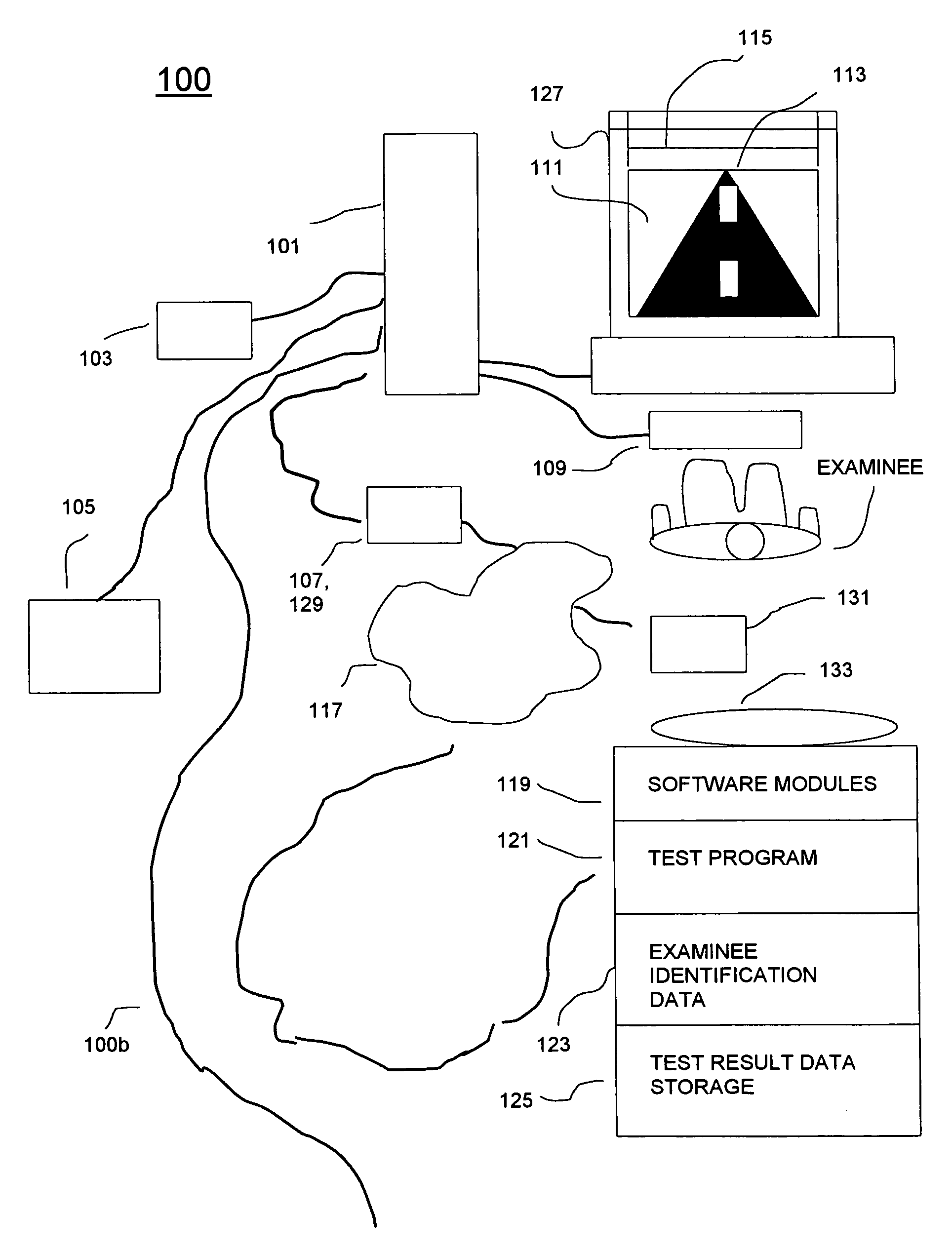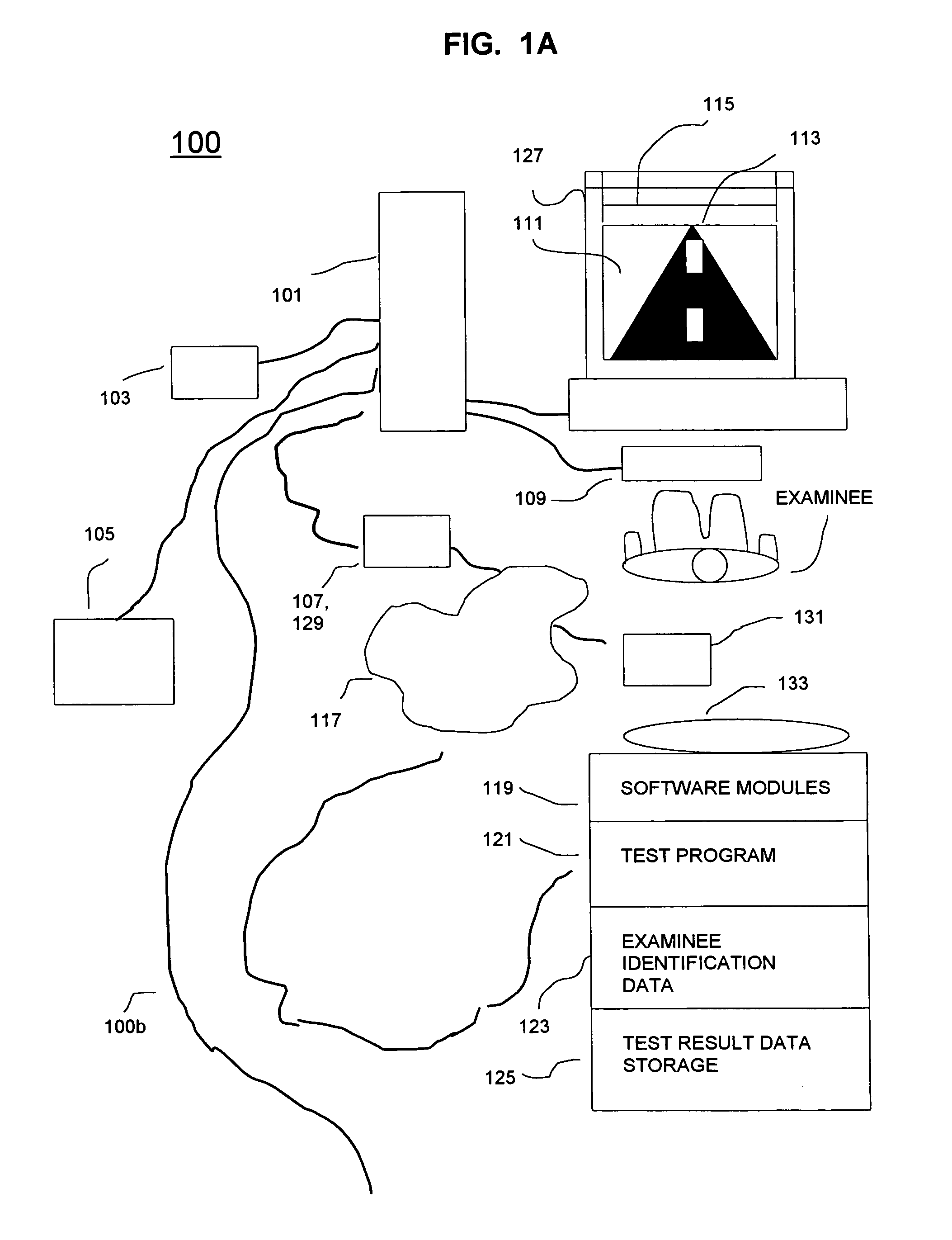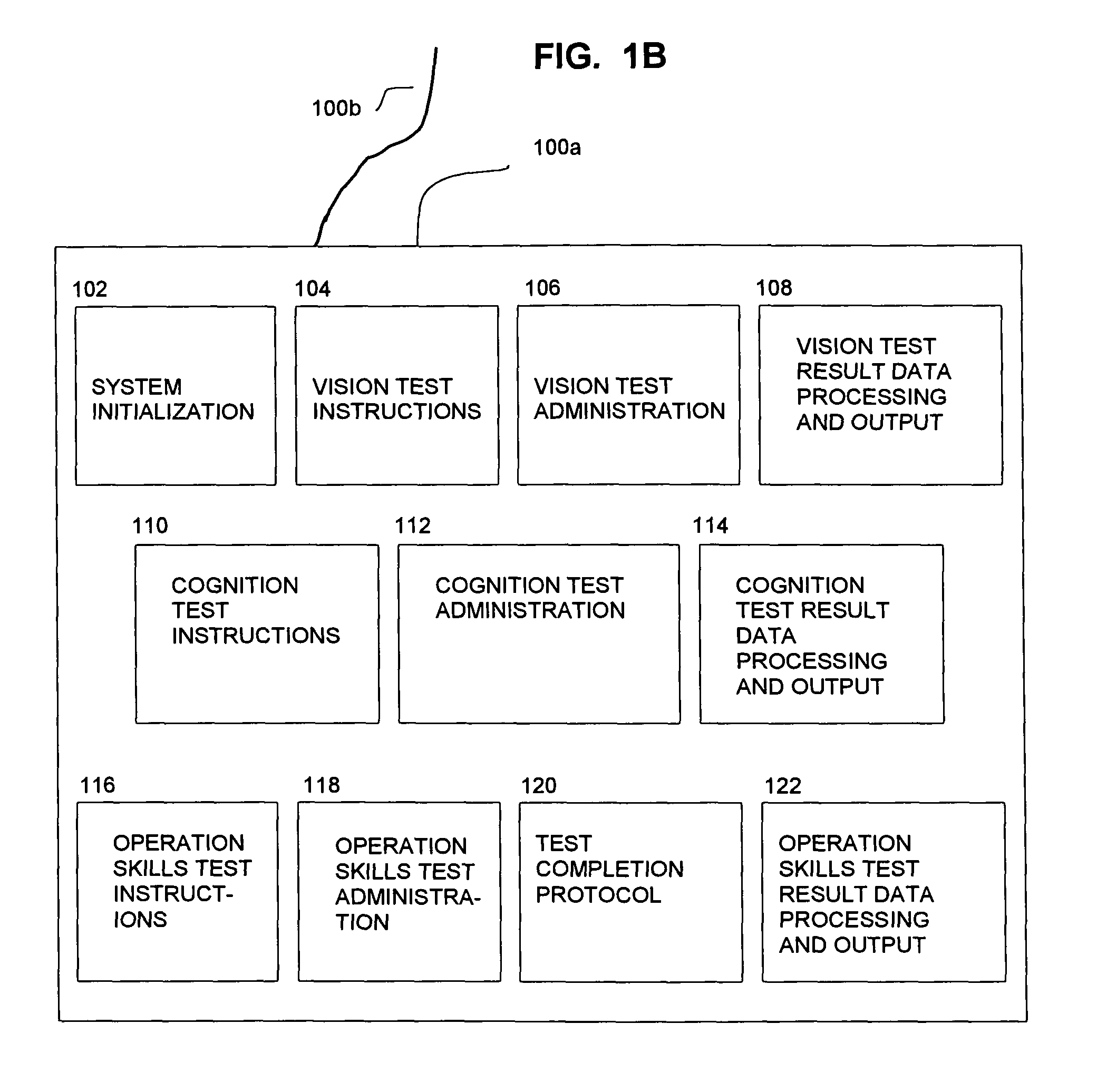Non-automatic tests tend to be subjective, time-consuming, costly, and heavily reliant on the experience of the examiner.
Non-automatic systems and methods suffer from a variety of problems.
They are inadequate forms of measuring visual, cognitive, and related capabilities.
No empirical evidence appears to support the effectiveness of current methods, such as those designed to screen individuals for licenses to operate vehicles in motion.
A lack of automated and comprehensive test measures may account for this dearth of data.
Still further current non-automated methods also fail to adequately, fairly, and rapidly screen inmates and law
enforcement personnel in security agencies, students in educational institutes, patients in medical establishments, and
service personnel and veterans of militaries, among others.
Non-
automatic testing techniques are also associated with mechanical failures, long queues,
cheating, memorization of testing materials, and costliness.
Still further, a lack of non-automatic instruction and scoring introduce bias into the testing processes.
Non-
automatic testing also lacks the capability to dynamically simulate conditions that exist, especially, for example, when one operates a vehicle in motion.
Such non-automatic techniques also complicate the process of testing and evaluating the masses of individuals who, for example, seek
licensure to operate a vehicle in motion or require annual or periodic health examinations.
Non-automatic vision screening machines, for example, are severely limited by their static conditions and inability to screen individuals for both potential eye diseases and vision loss conditions.
Studies show that these devices also tend to contribute to test fraud and memorization of optotypes.
No automatic systems and methods, such as those presented herein, are available-today that adequately, economically, thoroughly, and uniformly measure in whole or in part, an individual's vision,
cognition, operation skills and related capabilities.
Today's
license testing practices and equipment for operating vehicles in motion are antiquated and inadequate.
Each year, there are millions of collisions and injuries on American roads.
Thousands of motorists are killed.
Yet, dynamic
visual acuity, a measurement of the ability to discern detail of objects in motion, is not automatically offered for any transport or medical application.
Head trauma and eye trauma, common among victims of war, collisions in vehicles of motion, and falls are particularly damaging yet these are not easily detected or monitored with prior art devices .
Yet, until now, no automatic tests exist that can rapidly, uniformly, and effectively detect cognitive impairments, such as
Traumatic Brain Injury, a leading
cause of death and disability in motor vehicle accidents and wars.
It sometimes proves hazardous to drivers who may lose their sense of time or direction.
While there are various stages and varieties of
dementia, it is necessary to screen individuals because conventional testing methods and self assessments may not easily detect this condition.
Also, a person with
dementia may not recall any self-assessments.
A driver with
dementia poses risks to motorists.
Yet driver's license test personnel are not medically qualified to determine whether or not a driver has dementia or any
cognitive impairment.
Still further, only skilled or trained clinicians are qualified to administer and
score tests, yet a lack of uniformity and
automation prevents widespread use of cognitive tests.
Currently, no driving simulators exist in any driver's license bureau or other transportation license agency in the United States.
This stems primarily from high costs and simulator sickness concerns that some perceive as impediments to driving simulators.
For example, the 3-screen models tend to require additional expense and space.
Although computerized knowledge tests are offered in some driver's license bureaus, there is uncertainty as to their effectiveness.
In the healthcare industry,
automatic testing methods are needed due to challenges associated with
medical care access, time constraints, language barriers between clinicians and patients, emergency service responses, staff shortages, and the effective delivery of
medical consultation and treatment to the masses.
Yet, studies show that nearly 20% of Americans lack basic health care coverage.
Consequently, millions of drivers may not have access to regular or periodic vision examinations, cognitive tests, and related evaluations in a
medical setting.
These drivers may constitute a serious
collision risk because they may not be aware that their vision, cognition, and / or operation skills may be declining or posing threats to themselves and to others.
Yet, as discussed earlier, the driver's license test department personnel are not medically qualified to determine whether or not a driver has a cognitive, visual, or other impairment.
Therefore, these personnel cannot decide who can or cannot drive.
Long lines and staff shortages are commonplace at driver's license test offices.
Many offices now face closure.
Meanwhile, millions of hours of labor, gallons of
gasoline, and dollars in equipment are annually wasted.
Collectively, this leads to an excessive amount of
pollution that can be significantly reduced by automatic systems and methods of testing individuals.
The devices and systems currently in use fall short of attempting to arrest the effects of aging,
disease, disorder, injury, and trauma of the eyes and brain, among others.
Rather than focus on possible underlying causes of these collisions, such as driver's license testing methods, many people and organizations unjustly seek to solely accelerate the frequency of license renewal and testing periods.
While these on-site driver's license tests may, in the short term, allow for limited identification of drivers with impairments, they completely fail, in the long term, to improve the actual screening process and identify the most at-risk drivers.
There exists no scientific evidence that demonstrates that many drivers are active participants in these activities and that the individuals who utilize these assessment courses or tools volunteer to cease operating a motor vehicle on the bases of their scores.
Many individuals, particularly at- risk drivers, may not want to surrender their driver's license if they do not have alternative means of transportation.
These are issues that most states and countries now face as the older adult
population grows and necessitates adequate accommodations and testing methods to improve the
safe operation of vehicles in motion.
Although widespread among motor vehicle drivers, similar challenges exist among applicants and licensees in air, marine, rail, space, and military settings as individuals live longer and work longer.
Proposals and laws calling for a national driver's license, for example, may not be viable if an automated driver's license test is not implemented to reduce long lines, promote the sharing of data between states, and positively identify drivers.
Additionally, the absence of standardizations of
screening test methods, scoring, and / or reporting invites a number of individuals who may not qualify for a license in one state to obtain a license in another state.
Still further, in the security fields, automatic testing methods are sorely needed for objectivity.
Yet, if both the driver's license bureau and the
aviation agency offer automated testing and sharing of data, then this examinee is not issued a license at either agency.
In some
aviation, maritime, and rail agencies, requirements are limited to a physician's evaluation.
However, not all physicians are trained to detect visual, cognitive, operation skills, and related decrements.
At driver's license bureaus, testing is generally limited to a static
visual acuity test, a road test, and a written test.
Hence the
mass screening tests previously developed lack the unification or parsimony of methods outlined herein.
Yet,
visual acuity does not provide a comprehensive vision assessment.
Eye charts are particularly ineffective because patients can see dark letters through the cataract.
Prior art non-automated screening devices have the
disadvantage of test administration complexities, machinery breakdowns,
cheating, and increases in the probability of incurring an error with respect to determination of results, such as scoring.
Situational awareness tests are targeted particularly towards the automobile driver and are not suitable for other vehicles in motion.
Although these patents are generally satisfactory for their intended purposes, they are not completely automated because they require assistance or interpretation of complex output following the screening process.
They do not include a mechanism for preventing
cheating or dishonorable test taking practices.
Such technicalities limit the ability to adequately and effectively evaluate each eye independently for
disease.
Other methods, in addition to Fink et al., do not provide
user authentication identification techniques and automatic instruction to initiate the test process.
These changes may also include a significant rise in the number of collisions, injuries, and fatalities among older adults unless action is taken now to screen and ultimately monitor incompetent drivers, novice drivers, and at-risk drivers of all
age groups.
 Login to View More
Login to View More  Login to View More
Login to View More 


